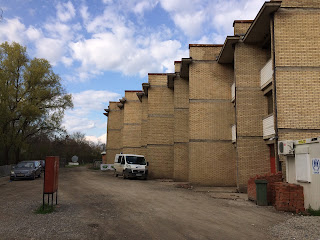I spent the first half this week at two refugee camps on the Serbian-Croatian border in Šid. Roughly 300 refugee families from Syria and Iraq have been living in these camps for a few weeks and will continue to do so indefinitely. Each day for the past week between ten and thirty people have fled, presumably putting their lives into the hands of smugglers. NGOs, too, are dwindling. Since the EU-Turkey deal lots of funding has either been cut or concentrated in efforts in Greece and Turkey so the NGO I worked with, for instance, will pull out on Sunday. The Serbian commissariat will keep running the camps without the NGOs so the refugees will have some support but far fewer individuals and significantly less sympathy. The commissariat employees, while kind to the volunteers, didn't seem to try to understand the refugees' circumstances and sometimes made fun of the children's behavior. The volunteers spend the days caring for and playing with the children, distributing food, and sorting through unused donated clothes to send to Greece.
Many of the children are only four or five years old, meaning they grew up in war since their births coincided with the start of the Syrian Civil War. While I'm not an expert in child psychology, this was evident in how some of them acted out; many of them fought physically and verbally with one another, stole or hoarded everything they could get their hands on, and sometimes seemed to be completely out of it, as if they were lost and didn't know what to think. Some of their behavior was frankly shocking, and the malicious deeds done to one another made me pause. But as Auden wrote, "Those to whom evil is done do evil in return." These children have grown all too familiar with malice and they respond in kind. I was reading recently about life-course epidemiology which basically shows how our state of health and risk of disease is an accumulation of everything we've encountered in life -- our genes, obviously, but also our social class, our exposure to trauma, our parents' exposure to trauma, our schooling, our jobs, our income, etc. This intuitive reasoning when applied to the refugees saddens me as it shows how many hurtles these children still have in front of them to overcome the baggage of their hardships. If only there were psycho-social workers who could begin to help the children work through what they've endured.
This situation seems to be settling down now that the borders are closed and these refugees, though not where they wish to be, are beginning to grasp some sense of constancy and normalcy. But we are so far from solving the question of how to handle this and other refugee crises. When people talk and write about migration it sounds like they think of it as these blips in time which corresponds to the short-term solutions we're providing. In actuality, people have always migrated and this occurrence will only intensify in the coming years as climate change and inevitable human barbarity leave more and more of the world uninhabitable.
When you connect to wifi at camps:
A motel in ex-Yugoslavia turned housing for refugees:
Inside the motel/camp. Not an especially inspiring environment but it's clean, warm, and equipped with electricity and running water so it satisfies fundamental needs.
Tents where the men live. Most of the fathers left several weeks or even months earlier and have already made it to Germany or wherever they intended to go. Those fathers who are in Šid, however, are not allowed to sleep in the motel with their families so they live in these tents provided by UNHCR.
Front of the motel:
Second camp in Šid -- opened just a few weeks ago. Like the motel, this camp was built set up on grounds that remained basically untouched for three decades, since the collapse of Yugoslavia in 1989. The main structure of this camp was once a children's hospital. The grounds have a few rundown pieces of playground equipment (a swing made of cloth, rusty seesaws) and volunteers wove a volleyball net. Again, it leaves something to be desired, but it's much better than overcrowded camps elsewhere in the Balkans.
Miksaliste -- Operating since last fall, this is the central aid stop in Belgrade. Though it's not a camp, refugees come here daily for breakfast, lunch, coffee/tea, and clothes/shoes and they hang out from 10am-4pm. There's also a children's center with games, crafts, and toys.







































